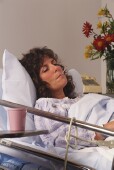- Skip Storing This Everyday Product in the Fridge Door
- Green Tea + B3 Pairing May Boost Brain Health
- Navigating Your Midlife Crisis: Embracing New Possibilities
- City Raccoons Showing Signs of Domestication
- Mapping the Exposome: Science Broadens Focus to Environmental Disease Triggers
- One Week Less on Social Media Linked to Better Mental Health
- Your Brain Changes in Stages as You Age, Study Finds
- Some Suicide Victims Show No Typical Warning Signs, Study Finds
- ByHeart Formula Faces Lawsuits After Babies Sickened With Botulism
- Switch to Vegan Diet Could Cut Your Greenhouse Gas Emissions in Half
Adjust the Lights, Hold the Morphine?


THURSDAY, Nov. 7Changing lighting patterns in hospital rooms to more closely align with normal sleep-wake cycles may improve patients’ health by reducing fatigue and pain, a new study suggests.
The findings highlight a simple and inexpensive way to improve patient care, according to the researchers.
Their study was designed to determine if there were any links between hospital lighting, mood, sleep and pain in adult patients. Twenty-three women and 17 men in a large U.S. hospital had their light exposure levels and sleep-wake cycles continuously monitored over 72 hours.
The patients’ moods were checked daily through questionnaires, and their pain levels determined from medical records, according to the study published online recently in the Journal of Advanced Nursing.
The patients were exposed mainly to low levels of light 24 hours a day and lacked the natural fluctuation between bright and low light required to help maintain normal sleep patterns.
The patients slept poorly, and the less light they were exposed to during the day, the greater their levels of fatigue. The more fatigued they felt, the more pain they had.
“It is important to note that these findings were preliminary, and more research needs to be done to determine any possible clinical implications of enhancing the lighting environment for patients in the hospital,” study author Esther Bernhofer, of the Cleveland Clinic in Ohio, said in a journal news release.
“Future intervention studies should include investigating different ‘doses’ of light exposure for medical inpatients,” she added. “Such research would determine if lighting interventions could offer unique, cost-effective ways to more effectively address the problems of sleep-wake disturbances, distressed mood, and pain in hospitalized patients, providing for overall better patient outcomes.”
More information
The U.S. National Institute of Neurological Disorders and Stroke has more about sleep.
Source: HealthDay
Copyright © 2025 HealthDay. All rights reserved.










